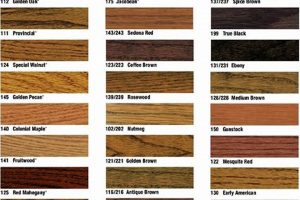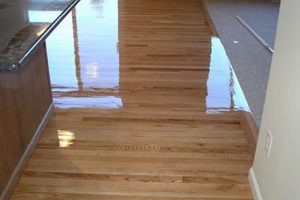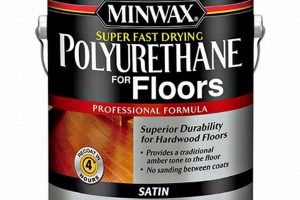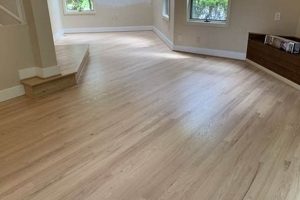A prepared cement-based surface layer, intended to serve as the final wear layer in a structure, achieves its desired properties through various treatments. These treatments can involve mechanical processes like polishing, grinding, or staining, and may include the application of sealants or coatings. For example, a warehouse might utilize a polished surface to enhance durability and reflectivity.
Such a surface offers numerous advantages, including longevity, ease of maintenance, and design versatility. Historically, it was predominantly employed in industrial settings, but its aesthetic appeal and durability have led to increasing adoption in residential and commercial environments. The inherent strength of the material contributes to its long-term cost-effectiveness, while a variety of finishing techniques allows for customization to suit diverse architectural styles.
The subsequent sections will explore specific techniques employed in achieving different surface characteristics, including coloring methods, sealant types, and the machinery involved in surface preparation and application. Further discussion will address the environmental considerations associated with these surfaces and best practices for long-term maintenance to ensure sustained performance.
Surface Preparation and Execution
Achieving a durable and aesthetically pleasing result requires meticulous attention to detail throughout the process. Improper planning or execution can lead to costly repairs and unsatisfactory outcomes.
Tip 1: Substrate Evaluation: Prior to any surface treatment, thoroughly assess the existing substrate. Identify and rectify any cracks, unevenness, or contamination. Improper substrate preparation can compromise the integrity of the treatment.
Tip 2: Moisture Control: Concrete’s moisture content significantly impacts the adhesion and performance of coatings and sealants. Conduct appropriate moisture testing to ensure the substrate meets manufacturer specifications before proceeding with surface application.
Tip 3: Aggregate Selection: When specifying newly poured concrete, carefully consider the type and size of aggregate. Aggregate composition affects the final aesthetic, durability, and grinding characteristics of the surface.
Tip 4: Consistent Mixing: During concrete mixing, strict adherence to specified water-to-cement ratios is critical. Inconsistent mixing can result in variations in strength, color, and surface texture.
Tip 5: Proper Curing: Adequate curing is essential for achieving optimal strength and minimizing cracking. Implement appropriate curing methods and maintain recommended moisture levels for the specified duration.
Tip 6: Surface Profiling: Before applying coatings or sealants, establish the appropriate surface profile as recommended by the manufacturer. This ensures proper adhesion and long-term performance.
Tip 7: Dust Control: During grinding and polishing operations, effective dust control measures are paramount. Employ high-efficiency particulate air (HEPA) filtration systems to minimize airborne dust and ensure a safe working environment.
Tip 8: Sealer Application: Apply sealers in accordance with the manufacturer’s recommendations, paying close attention to coverage rates and environmental conditions. Uneven application can lead to inconsistent appearance and reduced protection.
Adherence to these guidelines promotes superior results. Diligence in preparation, execution, and quality control translates to a robust, aesthetically pleasing, and long-lasting surface.
The following sections will delve into the specifics of various finishing techniques, providing a more in-depth understanding of each process.
1. Durability Enhancement
Durability enhancement represents a critical objective in the application of any surface treatment. The primary goal is to increase resistance to wear, impact, abrasion, and chemical exposure, thereby extending the lifespan of the surface and reducing long-term maintenance costs. Selection of the appropriate methods is paramount for achieving this enhanced resistance.
- Protective Coatings
The application of protective coatings, such as epoxy resins, polyurethanes, or acrylic sealers, forms a barrier against physical and chemical damage. In a high-traffic warehouse environment, an epoxy coating can prevent surface abrasion from forklift traffic and protect against chemical spills, significantly extending the floor’s lifespan.
- Surface Hardening Agents
Chemical hardeners, often silicate-based, penetrate the concrete surface and react with the cementitious materials, increasing surface density and resistance to abrasion. These are frequently used in retail spaces to resist the wear and tear of foot traffic.
- Polishing Techniques
Mechanical polishing increases surface density and reduces porosity, making it more resistant to staining and abrasion. A highly polished surface in a museum, for example, provides both aesthetic appeal and resistance to the daily wear from visitors.
- Fiber Reinforcement
Incorporating fiber reinforcement, either during the concrete mixing process or as a surface treatment, increases the material’s tensile strength and resistance to cracking. This is crucial in environments subject to heavy loads or ground movement, such as industrial facilities.
These methods, implemented individually or in combination, significantly enhance the performance characteristics of surfaces. The selection of the appropriate technique depends on the specific environmental conditions, anticipated traffic load, and desired aesthetic outcome. Proper implementation of these techniques is paramount for achieving long-term durability and minimizing maintenance costs.
2. Aesthetic Versatility
Aesthetic versatility represents a significant driver in the increased adoption of treated cement-based surfaces across diverse applications. The ability to tailor the surface’s appearance, ranging from mimicking natural materials to achieving highly customized designs, directly contributes to its appeal in residential, commercial, and industrial settings. This adaptability stems from a wide array of available treatments and techniques.
Coloring methods, such as integral pigments, stains, and dyes, enable the creation of surfaces that complement specific design schemes. Integral pigments, added during the concrete mixing process, provide uniform color throughout the material, ensuring consistent coloration even with wear. Stains, on the other hand, react chemically with the concrete, creating variegated and unique color patterns. Polishing techniques further enhance aesthetic options, allowing for varying degrees of reflectivity, from matte to high-gloss. Exposed aggregate techniques, where the aggregate is revealed through grinding or washing, provide a textured and visually appealing surface. For example, in retail spaces, polished surfaces with exposed aggregate can create a modern, industrial aesthetic while maintaining durability and ease of maintenance. Restaurants frequently use stained surfaces to achieve a warm and inviting ambiance.
The significance of aesthetic versatility extends beyond mere visual appeal. The capacity to customize surfaces allows architects and designers to create spaces that align with specific brand identities, functional requirements, and user experiences. The adaptability contributes to the material’s growing popularity as a flooring, countertop, and wall finish option. Challenges in achieving the desired aesthetic include ensuring color consistency across large areas and managing variations in aggregate distribution. However, proper planning, execution, and quality control mitigate these challenges, resulting in aesthetically pleasing and functional surfaces.
3. Cost-effectiveness
The economic viability of cement-based surface treatments stems from several factors, including initial material cost, installation expenses, long-term maintenance requirements, and potential for energy savings. While the initial investment might vary depending on the selected treatment and complexity of the project, the long-term benefits often offset higher upfront costs when compared to alternative flooring solutions. For instance, a polished surface requires significantly less maintenance than carpeting, eliminating the need for frequent cleaning or replacement due to wear and tear. This reduction in maintenance translates directly into lower operational expenses over the lifespan of the structure.
Furthermore, the thermal properties of cement-based materials contribute to cost savings through reduced energy consumption. Concrete’s thermal mass allows it to absorb and release heat, moderating temperature fluctuations within a building. This passive temperature regulation reduces the reliance on heating and cooling systems, resulting in lower energy bills. A warehouse utilizing an effectively insulated and treated cement-based surface can experience substantial reductions in heating costs during winter months and cooling costs during summer months. The durability of such a surface also minimizes the need for repairs or replacements, further contributing to its overall cost-effectiveness.
In conclusion, the cost-effectiveness of treatments is not solely determined by the initial price tag, but rather by a combination of factors encompassing material lifespan, maintenance requirements, energy efficiency, and potential for reduced lifecycle costs. A comprehensive analysis of these factors reveals that such surfaces can represent a financially prudent choice for a wide range of applications, particularly when considering long-term operational expenses and sustainability goals.
4. Surface Protection
Surface protection is an intrinsic aspect of a prepared cement-based surface, directly influencing its longevity, appearance, and resistance to environmental factors. Without adequate protection, the integrity of the prepared surface is compromised, leading to premature deterioration and increased maintenance demands.
- Sealers and Coatings
Sealers and coatings form a protective barrier against moisture intrusion, chemical attack, and abrasion. Acrylic sealers, for instance, provide a cost-effective means of preventing water damage in residential garages. Epoxy coatings offer enhanced resistance to chemical spills in industrial environments. Selection of the appropriate sealant or coating depends on the specific environmental stressors and desired performance characteristics.
- Penetrating Sealers
Penetrating sealers, such as silicates and siloxanes, react with the concrete matrix to increase surface density and reduce porosity. This process enhances resistance to staining and freeze-thaw damage. These sealers are commonly employed in exterior applications to mitigate the effects of weathering.
- Sacrificial Coatings
Sacrificial coatings are designed to be worn away over time, protecting the underlying prepared surface from damage. Wax coatings on polished surfaces serve as a sacrificial layer, absorbing minor abrasions and scratches. Periodic reapplication of the wax preserves the appearance of the polished surface.
- Stain Resistance
Protective treatments enhance resistance to staining from various substances, including oils, grease, and food spills. A properly sealed surface in a restaurant environment, for example, prevents permanent staining from spilled liquids and simplifies cleaning procedures. The selection of appropriate stain-resistant treatments is crucial for maintaining the aesthetic integrity of the surface.
These surface protection measures collectively contribute to the extended lifespan and sustained aesthetic appeal of the surface. Implementation of appropriate protective strategies minimizes maintenance requirements and preserves the investment in the initial surface preparation. The choice of specific protective measures should align with the anticipated usage, environmental conditions, and desired performance characteristics of the prepared surface.
5. Maintenance reduction
The adoption of a prepared cement-based surface frequently correlates with a significant reduction in long-term maintenance requirements. This reduction stems from the inherent durability of the material, coupled with the specific properties imparted by various finishing techniques. Surfaces treated with appropriate sealants and coatings exhibit increased resistance to staining, abrasion, and chemical degradation, thereby minimizing the need for frequent cleaning, repairs, or replacements. Polished concrete, for example, possesses a dense, non-porous surface that resists the penetration of liquids and contaminants, simplifying routine cleaning processes and reducing the likelihood of persistent stains. This is evident in large retail environments, where polished surfaces demonstrably decrease cleaning labor and material costs compared to traditional flooring options like carpet or tile.
The selection of appropriate surface treatments directly influences the extent of maintenance reduction. Epoxy coatings, known for their high resistance to chemicals and abrasion, are frequently employed in industrial settings to protect against spills and heavy traffic. These coatings minimize the need for frequent repairs or re-applications, leading to significant cost savings over time. Similarly, penetrating sealers enhance the durability and stain resistance of surfaces in exterior applications, reducing the impact of weathering and minimizing the need for periodic cleaning or resurfacing. A properly sealed surface in a high-traffic pedestrian area, for example, can withstand years of exposure to the elements with minimal maintenance beyond routine sweeping and occasional pressure washing.
In summary, the strategic implementation of a prepared cement-based surface, coupled with thoughtful selection of appropriate finishing techniques, translates into a demonstrably lower maintenance burden. This reduction in maintenance not only reduces operational costs but also minimizes disruptions to facility operations and extends the service life of the surface. The long-term economic and practical benefits of maintenance reduction represent a significant advantage in favor of cement-based surfaces for a wide range of applications.
6. Application methods
Effective implementation of a prepared cement-based surface mandates careful consideration of the application methods employed. The selected method directly influences the final appearance, durability, and overall performance of the surface. Factors such as the type of finish, environmental conditions, and skill of the applicator play critical roles in determining the most suitable approach.
- Pouring and Placement Techniques
The initial pouring and placement of the concrete mixture significantly impact surface quality. Proper consolidation techniques, such as vibration, eliminate air pockets and ensure uniform density. For instance, when creating a polished surface, consistent consolidation prevents surface imperfections that can detract from the final appearance. Incorrect placement can lead to cracking or uneven settling, compromising the intended finish.
- Spraying Applications
Spraying is frequently used for applying coatings, sealers, and stains. This method allows for even coverage and efficient application on large areas. Airless sprayers are commonly employed to achieve a uniform finish with minimal overspray. In industrial settings, spraying epoxy coatings provides a durable and chemically resistant surface. Improper spray techniques can result in uneven color distribution or coating thickness.
- Troweling and Hand Application
Troweling is a traditional method for creating smooth, level surfaces. Hand application is often used for applying decorative finishes, such as micro-toppings or overlays. These methods require skilled craftsmanship to achieve desired aesthetic results. Troweling imperfections can lead to unevenness or swirl marks, affecting the final appearance.
- Grinding and Polishing Processes
Grinding and polishing are mechanical processes used to refine the surface, expose aggregate, and achieve desired levels of reflectivity. These processes involve the use of specialized equipment and progressively finer abrasive pads. Polished concrete floors in commercial buildings require multiple grinding and polishing stages to achieve a high-gloss finish. Improper grinding techniques can result in scratches or uneven surfaces, detracting from the final appearance.
These diverse application methods underscore the importance of selecting the appropriate technique for each specific finish and environment. Skilled application, combined with proper preparation and materials, is essential for realizing the full potential of a prepared cement-based surface. The integration of these methods contributes significantly to the overall success and longevity of the finished product.
7. Substrate preparation
Substrate preparation constitutes a foundational stage in achieving a high-quality surface. The success and longevity of any applied finish are directly contingent upon the condition and treatment of the underlying concrete surface. Inadequate preparation inevitably leads to compromised aesthetics, reduced durability, and premature failure of the finish.
- Cleaning and Decontamination
The removal of surface contaminants, such as dirt, oil, grease, and existing coatings, is paramount. Contaminants impede adhesion of subsequently applied finishes, resulting in blistering, peeling, or cracking. For example, in an industrial setting, removal of oil spills and degreasing the concrete surface are essential before applying an epoxy coating. Failure to properly clean and decontaminate the substrate compromises the integrity of the bond between the concrete and the finish.
- Surface Profiling
Surface profiling involves creating a textured surface to enhance mechanical adhesion. Methods include grinding, shot blasting, and acid etching. The appropriate profile is determined by the type of finish being applied. Applying a self-leveling overlay typically requires a more aggressive profile than applying a simple sealer. An insufficient profile reduces the bond strength, leading to delamination or peeling of the finish under stress.
- Crack and Joint Repair
Addressing cracks and control joints is essential to prevent their propagation through the applied finish. Repairing cracks involves filling them with appropriate patching compounds, while control joints may require specialized treatments to accommodate movement. Ignoring these structural features results in reflective cracking in the finish, diminishing its aesthetic appeal and compromising its structural integrity.
- Moisture Mitigation
Controlling moisture vapor transmission through the concrete slab is crucial, especially for moisture-sensitive finishes. High moisture levels can lead to blistering, bubbling, or discoloration of the finish. Moisture testing and application of vapor barriers are common mitigation strategies. Installing a vapor barrier beneath a polished surface, for instance, prevents moisture from migrating upward and damaging the finish.
These substrate preparation techniques, when implemented meticulously, provide a stable and receptive base for the subsequent application of a prepared surface. Investing in thorough preparation translates to a durable, aesthetically pleasing, and long-lasting finished surface, minimizing future maintenance costs and maximizing the return on investment. The omission of even one of these key steps can significantly diminish the final quality and performance.
Frequently Asked Questions
The following section addresses common inquiries regarding the preparation and finishing of cement-based surfaces, providing concise and authoritative answers.
Question 1: What is the typical lifespan of a treated cement-based surface?
The lifespan is highly variable and depends on factors such as traffic volume, environmental conditions, and the specific finish applied. Properly maintained surfaces can last for decades, while those subjected to heavy wear or chemical exposure may require more frequent maintenance or replacement.
Question 2: Are these surfaces environmentally friendly?
The environmental impact depends on material sourcing, manufacturing processes, and disposal methods. Utilizing recycled aggregates, employing low-VOC coatings, and implementing proper waste management practices can minimize the environmental footprint. The longevity of the material also contributes to its sustainability by reducing the need for frequent replacements.
Question 3: What are the primary factors influencing the cost of a finished surface?
Cost drivers include surface area, complexity of the design, chosen finishing techniques, and the condition of the existing substrate. Intricate patterns, specialized coatings, and extensive surface preparation will increase project expenses.
Question 4: How can staining be prevented on a finished surface?
The application of appropriate sealers and coatings is crucial for preventing staining. The selection of the sealer or coating should align with the anticipated exposure to staining agents. Regular cleaning and prompt removal of spills are also essential preventative measures.
Question 5: Can a previously damaged concrete surface be successfully finished?
Successful finishing of a damaged surface requires thorough assessment and repair. Cracks, spalling, and unevenness must be addressed prior to the application of any finish. The extent of the damage will influence the complexity and cost of the repair process.
Question 6: What is the best way to maintain a finished cement-based surface?
Maintenance protocols vary depending on the type of finish. Regular sweeping, mopping with neutral detergents, and periodic reapplication of sealers are common practices. Avoiding harsh chemicals and abrasive cleaning agents is essential to prevent damage.
In summary, achieving optimal performance from a treated cement-based surface requires careful planning, proper execution, and diligent maintenance. Understanding these frequently asked questions facilitates informed decision-making throughout the project lifecycle.
The subsequent section will delve into case studies illustrating successful applications and highlighting best practices in various settings.
Conclusion
The preceding discussion has explored various facets of prepared cement-based surfaces, encompassing preparation techniques, aesthetic considerations, and long-term performance characteristics. These surfaces represent a versatile and durable solution across diverse applications, provided that appropriate methods and materials are employed.
Effective implementation necessitates a comprehensive understanding of substrate preparation, finishing techniques, and maintenance protocols. Further research and adherence to industry best practices are essential to maximize the potential of the finished concrete floor and ensure its sustained performance across its intended lifespan. Careful planning and execution are paramount.







